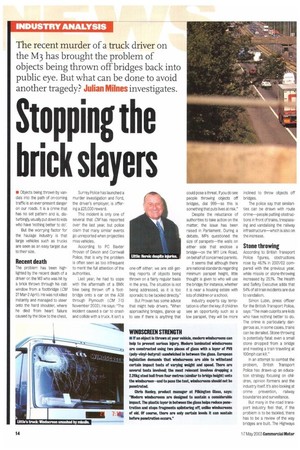Stopping the brick slayers
Page 14

Page 15

If you've noticed an error in this article please click here to report it so we can fix it.
II Objects being thrown by vandals into the path of on-coming traffic is an ever-present danger on our roads. It is a crime that has no set pattern and is, disturbingly, usually put down to kids who have 'nothing better to do'.
But the worrying factor for the haulage industry is that large vehicles such as trucks are seen as an easy target due to their size.
Recent death
The problem has been highlighted by the recent death of a driver on the M3 who was hit by a brick thrown through his cab wIndow from a footbridge (CM 27 Mar-2 April). He was not killed Instantly and managed to steer onto the hard shoulder, where he died from heart failure caused by the blow to the chest. Surrey Police has launched a murder investigation and Ford, the driver's employer, is offering a £25,000 reward.
This incident is only one of several that CM has reported over the last year, but police claim that many similar events go unreported when projectiles miss vehicles.
According to PC Baxter Proven of Devon and Cornwall Police, that is why the problem is often seen as too infrequent to merit the full attention of the authorities.
Last year, he had to cope With the aftermath of a BMX bike being thrown off a footbridge onto a car on the A36 through Plymouth (CM 7-13 November 2002). He says: "The incident caused a car to crash and collide with a truck. It isn't a one-off either; we are still getting reports of objects being thrown on a fairly regular basis in the area. The situation is not being addressed, as it is too sporadic to be tackled directly."
But Proven has some advice that might help drivers. "When approaching bridges, glance up to see if there is anything that could pose a threat. If you do see people throwing objects off bridges, dial 999—as this is something that puts lives at risk."
Despite the reluctance of authorities to take action on the matter, the issue has been raised in Parliament. During a debate, MPs questioned the size of parapets—the wails on either side that enclose a bridge—on the Mr Link Road, on behalf of concerned parents.
It seems that although there are national standards regarding minimum parapet height, little thought is given to who will use the bridge; for instance, whether it is near a housing estate with lots of children or a school.
Industry experts say temptation is often the key; if children see an opportunity such as a low parapet, they will be more inclined to throw objects off bridges.
The police say that similarities can be drawn with route crime—people putting obstructions in front of trains, trespassing and vandalising the railway infrastructure—which is also on the increase.
Stone throwing
According to British Transport Police figures, obstructions rose by 46.1% in 2001/02 compared with the previous year, while missile or stone-throwing increased by 25:1%. The Health and Safety Executive adds that 54% of all train incidents are due to vandalism.
Simon Lubin, press officer for the British Transport Police, says: "The main culprits are kids who have nothing better to do. The crime is particularly dangerous as, in some cases, trains can be derailed. Stone-throwing Is potentially fatal; even a small stone dropped from a bridge and meeting a train travelling at 100mph can kill."
In an attempt to combat the problem, British Transport Police has drawn up an education strategy focusing on children, opinion formers and the industry itself. It's also looking at crime prevention, railway boundaries and surveillance.
But many in the road transport industry feel that, if the problem is to be tackled, there has to be a review of the way bridges are built. The Highways Agency deals with bridges Over motorways and trunk roads, where most incidents happen. Within its jurisdiction comes provision for a safe parapet height and other safety features that may be incorporated to dissuade users from any unlawful acts, such as throwing objects.
The law states that parapet height should be a minimum height of 1.15m. Up until now, bridges have not been designed to incorporate features to dissuade objects being thrown, but with the problem becoming increasingly frequent, it may be time for it to be addressed.
Good news
And the good news is that the Highways Agency is currently reviewing the situation. It says: -A revision of the departmental standard which sets out the design criteria is currently taking place. The revised criteria, which are currently in draft form, will require project managers to consider existing or likely patterns in vandal
ism, and to consult with the police and others." So, it seems bridges huh in future may be built with a view to minimising problems.
But what about existing bridges? The Highways Agency says it is considering tackling this too: "Modifications to existing bridges are being considered at local level, where the Agency will consult with police and other local groups to agree the most appropriate solution to local problems."
The Highways Agency is expected to publish the revised departmental standard in autumn 2003.
































































































































































